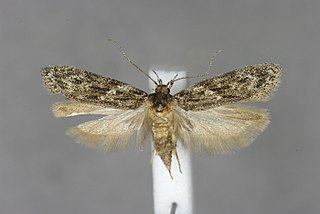
The Gelechiidae are a family of moths commonly referred to as twirler moths or gelechiid moths. They are the namesake family of the huge and little-studied superfamily Gelechioidea, and the family's taxonomy has been subject to considerable dispute. These are generally very small moths with narrow, fringed wings. The larvae of most species feed internally on various parts of their host plants, sometimes causing galls. Douglas-fir (Pseudotsuga) is a host plant common to many species of the family, particularly of the genus Chionodes, which as a result is more diverse in North America than usual for Gelechioidea.

Athrips is a genus of moths in the family Gelechiidae.

Brachmia is a genus of the twirler moth family (Gelechiidae). Among these, it is mostly placed in the subfamily Dichomeridinae.

Kiwaia is a genus of moths in the family Gelechiidae. Two subgenera are currently recognised, (i) the nominotypical subgenus with 25 species from New Zealand, and (ii) subgenus Empista with 4 species from the Palaearctic Region.
Polymitia is a genus of moths in the family Gracillariidae.
Opostega angulata is a moth of the family Opostegidae. It was described by Aleksey Maksimovich Gerasimov in 1930. It is known from Uzbekistan.

Isophrictis striatella is a moth of the family Gelechiidae. It is found in most of Europe, as well as Turkey and North America.

Dichomeridinae is a subfamily of moths in the family Gelechiidae.
Caryocolum huebneri is a moth of the family Gelechiidae. It is found in most of Europe, except Ireland, the Netherlands, the Iberian Peninsula, Norway, Finland, Estonia, Lithuania and most of the Balkan Peninsula. In the east, the range extends to the Ural Mountains.
Caryocolum peregrinella is a moth of the family Gelechiidae. It is found in northern Spain, the southern Alps, Bosnia and Herzegovina, North Macedonia and Greece.
Caryocolum pullatella is a moth of the family Gelechiidae. It is found in Austria, Italy, Denmark, Poland, Estonia, Latvia, Norway, Sweden, Finland, Ukraine, Russia, Japan, Alaska, Canada and the northern United States, south to Arizona in the west.

Gelechia muscosella, the grey sallow groundling, is a moth of the family Gelechiidae. It is widely distributed in Europe. Outside of Europe, it is found in the Caucasus, Siberia and the Russian Far East. The habitat consists of damp fenlands and shingle beaches.
Gelechia turpella, the grand groundling, is a moth of the family Gelechiidae. It is widely distributed in Europe. Outside of Europe, it is found from the Caucasus to Siberia and the Russian Far East. The habitat consists of woodlands and parks.

Psoricoptera gibbosella, the humped crest, is a moth of the family Gelechiidae. It is widely distributed in Europe. Outside of Europe, it is found in Turkey, North Africa, China, Japan, Korea, Siberia and the Russian Far East. The habitat consists of mature woodlands.
Tebenna chodzhajevi is a moth in the family Choreutidae. It was described by Aleksey Maksimovich Gerasimov in 1930. It is found in the Uzbek region Bukhara.
Brachmia dilutiterminella is a moth in the family Gelechiidae. It was described by Aleksey Maksimovich Gerasimov in 1930. It is found in Uzbekistan.
Peltasta is a genus of moths in the family Gelechiidae.
Peltasta gershensonae is a moth of the family Gelechiidae. It was described by Emelyanov and Piskunov in 1982. It is found in Mongolia.
Peltasta pseudozonula is a moth of the family Gelechiidae. It was described by Vladimir Ivanovitsch Kuznetsov in 1960. It is found in Turkmenistan and northern Iran.
Kiwaia jeanae, also known as the Kaitorete jumper or mat daisy jumper, is a species of moth in the family family Gelechiidae. It is endemic to New Zealand. This species is classified as "At Risk, Naturally Uncommon" by the Department of Conservation. Both the males and females of this species are brachypterous.







